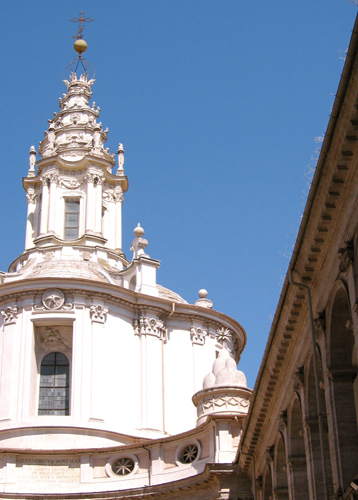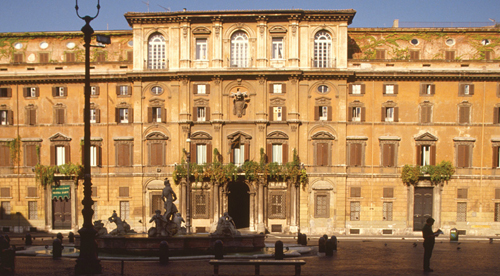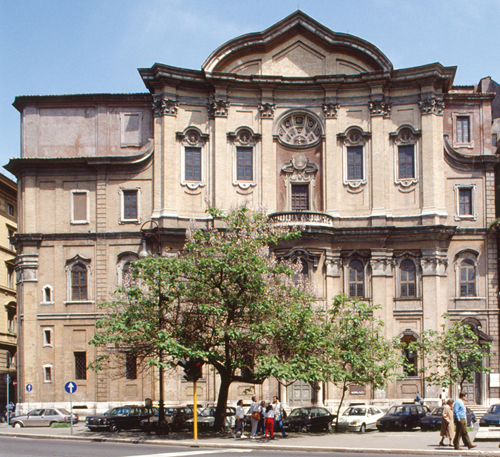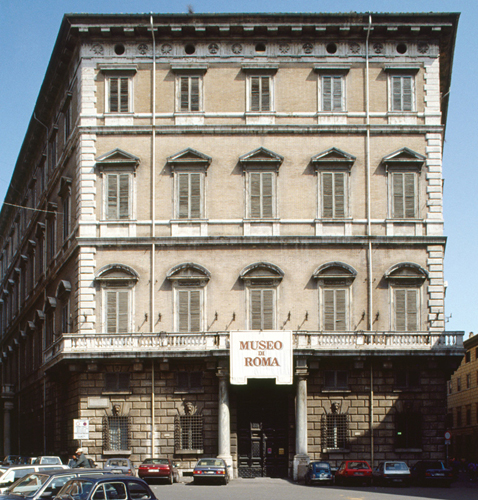Around Piazza Navona
This is Baroque Rome in all its theatrical glory, a collection of curvaceous architecture and elaborate fountains by the era’s two greatest architects, Bernini and Borromini, and churches filled with paintings by the likes of Caravaggio and Rubens. The street plan was largely overhauled by 16th- to 18th-century popes attempting to improve the traffic flow from St Peter’s – in fact, a 19th-century plan to turn Piazza Navona into a boulevard from Prati across Ponte Umberto I was only killed when wiser heads widened Corso del Rinascimento instead. However, ancient Rome does peek through in the shape of Piazza Navona and the curve of Palazzo Massimo alle Colonne. This is also a neighbourhood of craftsmen, shopkeepers and antiques restorers and dealers who line Via dei Coronari (see Antiques Shops). More recently the narrow alleys around Via della Pace have become a centre of Roman nightlife, with tiny pubs, trendy cafés and nightspots where the clientele spills out into the streets in summer (see Chic Cafés and Bars).
The Talking StatuesDuring the Renaissance, the most strident voices against political scandal and papal excess came from statues. Rome’s statue parlanti “spoke” through plaques hung around their necks by anonymous wags (although Pasquino was known to be a local barber). Pasquino’s colleagues included Marforio, Babuino on Via del Babuino and “Madama Lucrezia” on Piazza San Marco. |

|
Sights
Piazza Navona
One of Rome’s loveliest pedestrian squares (see Piazza Navona) is studded with fountains and lined with palaces, such as the Pamphilj, the church of Sant’Agnese, and classy cafés such as Tre Scalini.
Piazza Navona
Piazza Navona
Four Rivers Fountain
The statues ringing Bernini’s theatrical 1651 centrepiece symbolize four rivers representing the continents: the Ganges (Asia, relaxing), Danube (Europe, turning to steady the obelisk), Rio de la Plata (the Americas, bald and reeling), and the Nile (Africa, whose head is hidden since the river’s source was then unknown). The obelisk, balancing over a sculptural void, is a Roman-era fake, its Egyptian granite carved with the hieroglyphic names of Vespasian, Titus and Domitian.
Piazza Navona
The Ganges, Four Rivers Fountain
San Luigi dei Francesi
France’s national church in Rome has some damaged Domenichino frescoes (1616–17) in the second chapel on the right, but everyone bee-lines for the last chapel on the left, housing three large Caravaggio works. His plebeian, naturalistic approach often ran foul of Counter-Reformation tastes. In a “first draft” version of the Angel and St Matthew, the angel guided the hand of a rough labourer-type saint; the commissioners made the artist replace it with this more courtly one (see San Luigi dei Francesi). Underlying sketches in Martyrdom of St Matthew and Calling of St Matthew show how Caravaggio was moving away from symbolic compositions in favour of more realistic scenes.
Piazza S Luigi dei Francesi 5
Open 10am–12:30pm, 4–7pm
(closed Thu eve)
Free
Sant’Ivo
Giacomo della Porta’s Renaissance façade for the 1303 Palazzo della Sapienza, the original seat of Rome’s university, hides the city’s most gorgeous courtyard. The double arcade is closed at the far end by Sant’ Ivo’s façade, an intricate Borromini interplay of concave and convex curves. The crowning glory is the spiralling ellipse of the dome. The interior disappoints despite its Pietro da Cortona altarpiece. When the courtyard is closed, you can see the dome from Piazza Sant’ Eustachio.
Corso Rinascimento 40
Courtyard: open 8am– 8pm Mon–Fri, 9am–noon Sun
Church: open 10am–4:30pm Mon– Fri, 10am–1pm Sat, 9am–noon Sun
Free
Spire and lantern, Sant’Ivo
Sant’Agostino
Raphael frescoed the prophet Isaiah (1512) on the third pillar on the right, and Jacopo Sansovino provided the pregnant and venerated Madonna del Parto; but Sant’Agostino’s pride and joy is Caravaggio’s Madonna del Loreto (1603–1606). The master’s strict realism balked at the tradition of depicting Mary riding atop her miraculous flying house (which landed in Loreto). The house is merely suggested by a travertine doorway and flaking stucco wall where Mary, supporting her overly large Christ child, is venerated by a pair of scandalously scruffy pilgrims.
Piazza di Sant’Agostino
Open 7:30am–12:30pm, 4–6:30pm daily
Free

Santa Maria della Pace
Baccio Pontelli rebuilt this church for Pope Sixtus IV in 1480–84, but the lovely and surprising façade (1656–7), its curved portico squeezed into a tiny piazza, is a Baroque masterpiece by Pietro da Cortona. Raphael’s first chapel on the right is frescoed with Sibyls (1514) influenced by the then recently unveiled Sistine ceiling (see Sistine Chapel Work). Peruzzi decorated the chapel across the aisle and Bramante’s first job in Rome was designing a cloister based on ancient examples. It now hosts frequent concerts.
Via della Pace
Open 9am–noon Mon, Wed, Sat
Free
Palazzo Altemps
This 15th-century palace was overhauled in 1585 by Martino Longhi, who is probably also responsible for the stucco and travertine courtyard (previously attributed to Antonio da Sangallo the Younger or Peruzzi). It now makes an excellent home to one wing of the Museo Nazionale Romano, its frescoed rooms filled with ancient sculptures.

Pasquino
That this faceless, armless statue was part of “Menelaus with the body of Patroclus” (a Roman copy of a Hellenistic group) is almost irrelevant. Since this worn fragment took up its post here in 1501, it has been Rome’s most vocal “Talking Statue”.
Piazza Pasquino
Pasquino, Piazza Pasquino
Palazzo Massimo alle Colonne
This masterpiece of Baldassare Peruzzi marks the transition of Roman architecture from the High Renaissance of Bramante and Sangallo into the theatrical experiments of Mannerism that would lead up to the Baroque. The façade is curved for a reason; Peruzzi honoured Neo-Classical precepts so much he wanted to preserve the arc of the Odeon of Domitian, a small theatre incorporated into the south end of the emperor’s stadium (see Palazzo Massimo alle Colonne).
Corso Vittorio Emanuele II 141
Open 7am–1pm 16 Mar only
Free
Palazzo Massimo alle Colonne
Palazzo Madama
Based around the 16th-century Medici Pope Leo X’s Renaissance palace, the Baroque façade of unpointed brick and bold marble window frames was added in the 17th century. Since 1870 it’s been the seat of Italy’s Senate, so public admission is obviously limited.
Piazza Madama 11
Open for guided tours 10am–6pm 1st Sat of month
Free
Stone relief, Palazzo Madama
A Morning around Piazza Navona
Start in the courtyard of the Sapienza, marvelling at the remarkable façade of Sant’Ivo . Head around the church’s right side and out the back exit on to Via della Dogana Vecchia. If you need a morning pick-me-up, turn left and then right into Piazza Sant’Eustachio (if the namesake church is open, pop in for an early 18th-century interior). In the elongated piazza to the left are fine views of Sant’Ivo’s dome and two great cafés to choose from, Camillo and Sant’ Eustachio.
Return to Via della Dogana Vecchia and turn right to visit the Caravaggio works inside San Luigi dei Francesi . Continue up the street to Via delle Coppelle and turn left for more Caravaggio at Sant’Agostino. Continue into Piazza delle Cinque Lune and walk a few yards to the left down Corso del Rinascimento (see Sant’Ivo) and browse the quality liqueurs and old-fashioned beauty products, all made by monks.
Around the corner is Palazzo Altemps, now full of Classical statuary. Spend a good hour inside. Then relax from the morning’s sightseeing with a stroll amid the street performers and splashing fountains of Piazza Navona . Enjoy a tartufo ice cream or a full lunch at the wonderful Tre Scalini , before ending the morning window-shopping along the antiques of Via dei Coronari .
Best of the Rest

Sant’Agnese in Agone
This church was built in honour of a 13-year-old girl who was stripped in a brothel but whose hair miraculously grew to cover her nakedness. Borromini’s façade is a wonderful play of concave and convex shapes.
Piazza Navona
Open 9:30am–12:30pm, 3:30–7pm Tue–Sat, 10am–1pm, 4–7pm Sun & hols
Free
St Agnes statue, Sant’Agnese in Agone
Domitian’s Stadium
The outline of this AD 86 stadium is echoed in Piazza Navona, built on top of its remains.
Piazza di Tor Sanguigna
060608
Open special occasions and by request
Adm
Via dei Coronari
Lined with antiques shops, this street is at its torch-flickering best during the May and October antiques fairs (see Via dei Coronari).

Sant’Antonio dei Portoghesi
A Baroque gem of a church. Out front is the Torre della Scimmia, a rare remnant of medieval Rome.
Via dei Portoghesi
8:30am–1pm, 3–6pm Mon–Fri, 8:30am–noon Sat, 9am–noon Sun
Free
Santa Maria dell’Anima
Highlights in this gilded church are a Giulio Romano altarpiece and Peruzzi’s Hadrian VI tomb (1523).
Vicolo della Pace 20
Open 9am–12:45pm, 3–7pm daily
Free
Museo Napoleonico
A collection of paintings, furnishings and objets d’art that once belonged to the Bonaparte clan.
Piazza di Ponte Umberto I
Open 9am–7pm Tue–Sun
Adm
San Salvatore in Lauro
A chapel in this church houses da Cortona’s Adoration of the Shepherds (1630).
Piazza S Salvatore in Lauro 15
Open 4:30–7pm Mon–Sat, 8am–1pm, 4:30–7pm Sun
Free
Antiques Shops

Antica Cappelleria Troncarelli
Don’t be fooled by the tiny size of this shop – it is still one of the best haberdashers in Rome, established in 1857.
Via della Cuccagna 15
Gea Arte Antica
Own your own piece of ancient Rome. Choose from a range of objects, from simple oil lamps to exquisite painted vases.
Via dei Coronari 233A
Massimo Maria Melis
This unique jewellery studio wraps 21-carat gold around coins, glass and stones preserved from the Etruscan, Roman and medieval eras.
Via dell’Orso 57
Galleria Il Colibri
Small but worthy gallery presenting group and solo shows of contemporary painters, as well as historic posters and other types of art media.
Via dell’Orso 92
Dott. Sergio de Sanctis
Exclusively Italian antiques, mostly elegant 18th- to early 20th-century furnishings and gilt-framed mirrors.
Via dei Coronari 218–19
L’Art Nouveau
Antiques shop devoted to Art Nouveau and Liberty style furnishings, lamps, objets d’art and chinoiserie silk tapestries and gowns.
Via dei Coronari 221
Calzoleria Petrocchi
Bruno Ridolfi keeps alive the high fashion, excellent quality, made-to-measure cobbler traditions of his uncle Tito Petrocchi, who regularly shod glamorous stars of stage and screen in the “dolce vita” heyday of the 1950s and 1960s.
Via dell’Orso 25
Nardecchia
Prints, old photographs and watercolours are on sale here, from Piranesi originals to 20th-century works.
Piazza Navona 25
Chic Cafés and Bars

Tre Scalini
This historic café, right on Piazza Navona, is renowned for its delectable chocolate homemade tartufo ice cream ball (see Tre Scalini).
Piazza Navona 28
Tre Scalini
Jonathan’s Angels
Perhaps Rome’s most unique and kitsch nightspot, which should be seen to be believed. Run by a former circus acrobat, it is eccentrically decorated, with a piano bar, tables out on the narrow alley strung with fairy lights, and the occasional impromptu floor show.
Via della Fossa 16
Cul de Sac
One of Rome’s oldest wine bars, with lots of labels on offer. A bit of a squeeze inside and out, but a better option than the nearby bars of the Piazza Navona.
Piazza Paquino 73
Bull Dog Pub
American style bar positively hopping nightly with plenty of lively young students both foreign and Italian
Corso Vittorio Emanuele II 107
Bloom
The former Clochard nightclub was reborn in 2001 as a jazzy modern bar, with a sushi restaurant upstairs – a rare find in Rome.
Via del Teatro Pace 30
Bramante
Café/bar with a quirky elegance amid a sea of pubs. Light dishes are served to a chic young crowd.
Via della Pace 25
Bar del Fico
An alternative, chic hangout in the shade of the legendary fig tree in a tiny square, where you can sit inside or out and enjoy a morning cappuccino or a very late liqueur.
Piazza del Fico
La Botticella
Small, always crowded birreria (beerhouse) with some tables outside, in the heart of the area’s nightlife action. Devil’s Kiss and Castlemaine XXXX beer are on tap.
Via di Tor Millina 32
Old Bear
Eclectic but good food accompanies a wide range of beers here, with live music played in the basement.
Via dei Gigli d’Oro 2–4
Places to Eat

Da Francesco
An abundant appetiser buffet offering hand-cut prosciutto, fresh seafood salads and many vegetarian options.
Piazza del Fico 29
06 686 4009
Closed Tue; closed Aug: Mon, Tue and at lunch
DA
Terra di Siena
One of the best Tuscan restaurants in Rome. The family imports ingredients and classic seasonal recipes from the farmers around their hometown near Siena.
Piazza Pasquino 77–8
06 6830 7704
Closed Sun
Lilli
An ex-footballer runs this ultra-traditional restaurant hidden away in a cul-de-sac next to the riverside boulevard. If you are looking for a true taste of Rome’s cuisine, the recipes don’t get more Roman than this.
Via Tor di Nona 23
06 686 1916
Closed Mon, Sun lunch
Il Convivio
For a special night out. One of the historic centre’s best restaurants, with strictly seasonal cuisine based on Italian traditions and an excellent wine list.
Vicolo dei Soldati 28
06 686 9432
Closed Sun
Insalata Ricca 2
Rome’s mini-chain of vegetarian-orientated eateries. Inventive salads are the mainstay, although they also offer good pasta dishes. Seating outdoors.
Piazza Pasquino 72
06 6830 7881
Pizzeria La Montecarlo
The offspring of Baffetto’s owners run this joint. Has less ambience than its famous parent, but benefits from shorter queues (see Pizzeria La Montecarlo).
Vicolo Savelli 12
06 686 1877
Closed Mon
Tre Archi
A local trattoria with two small rooms and a famed Roman set menu.
Via dei Coronari 233
06 686 5890
Closed Sun
Fraterna Domus
Communal dining in a hospice run by nuns. The set menu offers soup or pasta, a meat course and salad and fruit for dessert.
Via di Monte Brianzo 62
06 6880 5475
Closed Thu
Zio Ciro
This pizzeria is popular for its al fresco dining and the chance to order large pizzas with two or three different toppings.
Via della Pace 1
06 686 4802
Antica Taverna
The owners of this taverna get the goat’s milk ricotta and rabbit from their hometown in the Sabine Hills.
Via Monte Giordano 12
06 6880 1053
|







